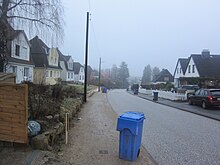Kroog
Kroog is a settlement area in the southeast of Kiel . Neighboring districts are Elmschenhagen in the north, Rönne in the southwest and the city of Schwentinental in the east. The district image is mainly characterized by single-family houses. There has been an evangelical church in Kroog since 1962 (St. Stephanus, which belongs to the Trinitatis parish ).
Kroog is officially not a separate district, but belongs to Elmschenhagen, but the city district is called Elmschenhagen / Kroog . Historically, Kroog can also be viewed as a separate district: the old town center of Elmschenhagen around the Maria Magdalenen Church and the former Dorfkrug is to the north, and Hof Kroog is south of Wellsee .
history
The forest village of Kroog - then spelled Croch - was first mentioned in 1286 in the Bocholt register of the Preetz monastery . The register initiated by Konrad Bocholt contains the names of the provosts and a list of the villages belonging to the land and judicial rule of the monastery and their taxes. The register states that Kroog was obliged to pay 9 marks, 15 pots of linen in kind and 21 chickens, and two days of weekly services to the monastery. In contrast to other villages, however, no population is given in the register. This suggests that Croch was just a single farm at the time. Presumably it was run by nuns from the Preetz monastery. There were other such estates in the area, but not much is known about them apart from the name.
However, the remains of a village were found on the site of today's Kroog. Among other things, there must have been a brick factory in the village . In later records, Kroog was referred to as Hof Kroog or Hof to dem Kroghe . Since the church there was built, Kroog has belonged to the Elmschenhagen parish. In 1895 the place Kroog had 52 inhabitants.
Today's Kroog settlement was founded in 1913. At that time, the owner of the Kroog August Witt farm wanted to sell part of his land as an industrial area. However, he did not find any interested parties. The architect Fritz Kröger and the town planner Albin Huss persuaded him to build a villa settlement on the site instead. The corresponding contract was signed on August 14, 1913. On April 4, 1914 the foundation stone of the new settlement was laid. First of all, villas were built, in the poor economic situation around 1923 and after 1929 also some semi-detached and multi-family houses.
After the parliament under Chancellor Heinrich Brüning passed the Third Emergency Ordinance of October 6, 1931 , which allowed the unemployed to build their own house, new houses were built in Kroog from 1933 onwards. In the 1950s, too, was built in Kroog. In the 1980s, the new building area around the Am Wellsee bus stop was built .
literature
- Robert Möller: Our Kroog. From the forest village to the district. Dannenberg'scher Verlag, Plön o. J. (1986).
Web links
- Interest group Naturfreunde Kroog
- Lots of photos and information about the local history of Kroog
- Kroog in the Stadtwiki Kiel
Individual evidence
- ↑ Robert Möller: Our Kroog. From the forest village to the district. Dannenberg'scher Verlag, Plön o. J. (1986), p. 9f.
- ^ Part IV, Chapter II, § 1 Text in the Reichsgesetzblatt, alex.onb.ac.at
Coordinates: 54 ° 17 ' N , 10 ° 12' E

